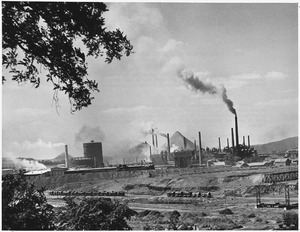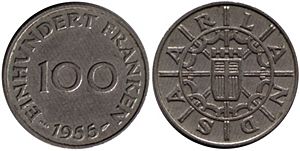Saar Protectorate facts for kids
Quick facts for kids
Saarland
|
|||||||||
|---|---|---|---|---|---|---|---|---|---|
| 1947–1956 | |||||||||
|
Anthem: Saarlandlied
|
|||||||||

Germany in 1947
|
|||||||||
| Status | Disputed territory of Germany French protectorate |
||||||||
| Capital and largest city
|
Saarbrücken 49°14′N 7°0′E / 49.233°N 7.000°E |
||||||||
| Common languages |
|
||||||||
| Religion | Secular state | ||||||||
| Demonym(s) | Saarlander or Saar | ||||||||
| Government | Unitary parliamentary republic | ||||||||
| French Representative | |||||||||
|
• 1947–1955
|
Gilbert Grandval | ||||||||
|
• 1955–1956
|
Charles de Carbonnel | ||||||||
| Minister-President | |||||||||
|
• 1947–1955
|
Johannes Hoffmann | ||||||||
|
• 1955–1956
|
Heinrich Welsch | ||||||||
|
• 1956
|
Hubert Ney | ||||||||
| Legislature | Landtag | ||||||||
| Historical era | Cold War | ||||||||
|
• Establishment
|
17 December 1947 | ||||||||
|
• Saar statute
|
23 October 1954 | ||||||||
|
• Referendum
|
23 October 1955 | ||||||||
|
• Saar Treaty
|
27 October 1956 | ||||||||
|
• Integration into West Germany
|
1 January 1957 | ||||||||
| Currency |
|
||||||||
|
|||||||||
| Today part of | Germany | ||||||||
The Saar Protectorate was a special area in Europe after World War II. It was officially called Saarland and was a protectorate under French control. This means France helped govern it, even though it was still considered part of Germany.
The Saar Protectorate was a disputed territory, meaning different countries disagreed about who it belonged to. When it joined West Germany in 1957, it became the smallest "federal state" (like a US state) in Germany. It's named after the Saar River.
This region is important because it has lots of minerals, especially coal. It was a big center for industry during the Industrial Revolution in Germany. Around 1900, it was one of the largest areas for coal, iron, and steel production.
After World War I, from 1920 to 1935, the Saar region was controlled by the League of Nations. Then, in 1935, Nazi Germany took full control. After World War II, the Allies (like France and the US) wanted to reduce Germany's industrial power. However, the Cold War changed things, and the Saar region was allowed to re-industrialize. France eventually returned control to West Germany.
Contents
The Saar Region After World War II
After World War II ended in Europe in July 1945, Allied forces moved into their assigned zones. On July 10, 1945, US troops left the Saar, and French troops took over. France then separated the Saar from the main Allied occupation zones in Germany. This meant the Saar was no longer under the joint control of all Allied powers.
French officials sent some people away from the Saar in 1946 and 1947. Most of them were later allowed to come back. France did not agree to accept war refugees from other parts of Germany. However, people from the Saar who had been forced to leave by the Nazis, like political or Jewish refugees, were allowed to return. France hoped to gain the support of the Saar people for the region to become part of France.
A Look Back at Saar's History
The Saar region has a long history of being connected to France. It was part of France during the Napoleonic Wars between 1798 and 1814.
Saar After World War I
After World War I, the Treaty of Versailles placed the Saar under the control of the League of Nations. This was a special arrangement that lasted for 15 years. Troops from Italy, Sweden, and the United Kingdom were stationed there.
France took control of the Saar's coal industry. This was to make up for the damage the Germans caused to French mines during the war.
The 1935 Vote
On January 13, 1935, the people of the Saar voted on their future. Most voters, 90.7%, chose to return to Germany. Only 0.4% wanted to join France, and 8.9% wanted to stay under League of Nations control.
After this vote, the Saar region became part of Nazi Germany again. It was renamed "Saar-Palatinate."
Saar After World War II
As mentioned, US forces left the Saar in July 1945, and French troops took over. France then made the Saar a separate protectorate in February 1946. This meant it was no longer under the joint control of all the Allied powers.
France continued to manage who could live in the Saar. They did not accept refugees from other parts of Germany. However, native Saarlanders who had been forced to leave during the war were allowed to return. France wanted the people of the Saar to support joining France.
Over time, some small changes were made to the Saar's borders. Some towns were added, and some were returned to Germany. In 1946, the US Secretary of State, James F. Byrnes, said that the US supported France's claim to the Saar. This was because France had been invaded by Germany three times in 70 years.
On July 16, 1947, the Saar mark became the official money in the Saar Protectorate. Later, in November, the Saar joined the French currency system. From 1954, only French franc banknotes were used, but special Saar franc coins were also made.
On December 15, 1947, the Saar became the "Saarland" with its own constitution. It had an elected government, but it was still overseen by the French high commissioner, Gilbert Grandval. A customs union with France began on April 1, 1948.
After the war, the Allies initially tried to limit Germany's industrial production. Factories in the Saar were taken apart, similar to other parts of Germany. However, this policy was soon changed in 1946-1947.
France had wanted to control the Ruhr industrial area in Germany. But as the Cold War began, France realized that working together with Germany was better for Europe. This led to the Schuman Declaration, a plan for France and Germany to combine their coal and steel industries. This created the European Coal and Steel Community (ECSC). This was a big step towards what is now the European Union.
Under French rule, political parties that supported Germany were not allowed to run in elections at first. A group that wanted the Saar to join France was very popular. However, in the 1952 election, many people voted blank ballots to show support for the banned pro-German parties.
Saar's Referendum and Joining West Germany
In 1954, France offered to make the Saarland an independent country. This plan was put to a vote on October 23, 1955. The people of the Saar rejected this plan by a large margin (67.7% against). This vote showed that most people wanted the Saar to join West Germany.
On October 27, 1956, the Saar Treaty was signed. This agreement allowed the Saarland to become a state of West Germany. This happened on January 1, 1957. West Germany agreed to improve the Moselle River for shipping, which helped French steel companies. West Germany also agreed that French would be the first foreign language taught in Saarland schools.
Even though the Saar became part of West Germany in 1957, the French franc was still used as money until July 6, 1959. This date marked the complete "little reunification" of the Saar with Germany.
The dispute over the Saarland was one of the last disagreements between countries that later formed the European Union. This is why the European flag has 12 stars, representing unity, instead of 15 as originally suggested.
Leaders of the Saar Protectorate
The first elections for the Saar parliament were held on October 5, 1947. Four parties were allowed to participate. The Christian People's Party of Saarland (CVP) and the Social Democratic Party of Saarland (SPS) formed the first government.
- 1947–1955: Johannes Hoffmann (CVP) was the first Minister-President. He resigned after the plan for an independent Saar failed in the vote.
- 1955–1956: Heinrich Welsch (independent) led the government.
- 1956–1957: Hubert Ney (CVP) was the last Minister-President before reunification.
French Representatives
These officials represented France in the Saarland during its time as a protectorate.
High Commissioner of the French Republic in the Saarland
- Gilbert-Yves-Edmond Grandval: January 10, 1948 – March 5, 1952
Chiefs of the Diplomatic Mission of the French Republic in the Saarland
- Gilbert-Yves-Edmond Grandval: January 1, 1952 – July 8, 1955
- Charles-Marie-Eric de Carbonnel: July 8, 1955 – October 27, 1956
Sports in the Saar Protectorate
The Saar Protectorate even had its own sports teams!
- The Saar competed in the 1952 Summer Olympics in Helsinki.
- The Saarland national football team tried to qualify for the 1954 FIFA World Cup. They came in second in their group, behind West Germany but ahead of Norway.
- Helmut Schön, who later became a famous coach for West Germany, managed the Saarland team from 1952 until 1957.
- The local football league was called the Amateurliga Saarland.
- The football club 1. FC Saarbrücken even played in the very first European Cup in 1955.
Postage Stamps
The Saar Protectorate had its own postage stamps. These were issued from 1920 to 1935, and again from 1947 to 1959. You can learn more about them in the article about postage stamps and postal history of the Saar.
See also
 In Spanish: Protectorado del Sarre para niños
In Spanish: Protectorado del Sarre para niños
- Sarre, a French department from 1798–1814
- Saar River
- Kehl
- List of French possessions and colonies






